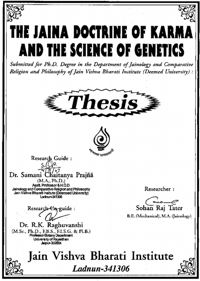Dravya Karma And Bhāva Karma
Jainism is, in a sense, dualistic. The universe is constituted of the two fundamental categories:
- jīva (living)
- ajīva (non-living).
Soul (jīva) has been described from the nominal and phenomenal point of view. From the pure and ultimate point of view, jīva is pure and perfect. It is characterized upayoga, the hormic energy. It is simple and without parts. It is immaterial and formless.[8] It is characterized by cetanā. It is pure consciousness. From the phenomenal point of view jīva is described as possessing four prāṇas. It is Lord (prabhu) limited to his body (dehamātra), till incorporeal, and it is ordinarily found with karma. [9]
The jīva comes in contact with ajīva the external world. The jīva is active and the activity is expressed in the threefold forms physical, vocal and mental. This is called yoga. Yoga, in turn, brings effects as the bondage of new karmic particles, which in turn, veil the pure nature of the soul. The soul is contaminated by the karma, which is a foreign element and is involved in the wheel of saṁsāra. This contamination is beginningless, though it has an end. It is difficult to say how the soul got involved in the wheel of saṁsāra. In the beginningless wheel of saṁsāra the soul forgets its real nature and in result does not know what is truth. The inherent capacity of soul for self realization is also obstructed by the veil of karma. [10] It is subjected to the forces of karma which express themselves first through feelings and emotions, and secondly, in the chains of very subtle kinds of matter invisible to the eyes and the instruments of science. It is then embodied and is effected by the environment, physical, social and spiritual, we, thus, get various types of soul existence.
Karma according to Jains is material in nature. It is a matter in its subtlest form and it is a kind of psycho-physical force. It is constituted of finer particles of matter. The matter fit to manifest as karma is filled in the universe. It has the special property of developing the effects of merit and demerit. By its activity due to the contact with the physical world, the soul becomes penetrated with the particles of karmic body (karma śarīra) which is constantly attracted to the soul till it succeeds to be free from it. Nowhere has the physical nature of karma been asserted with such stress, as in Jainism.[11] A moral fact produces a psycho-physical quality, a real and not merely a symbolic mark, affecting the soul in its physical nature. This point of view has been worked out in detail in the form of mathematical calculations in the karmagranthas. The Jaina tradition distinguishes two aspects:
- Dravya karma:
It's physical aspect compiles the particles of karma (karma-pudgala) accruing into the soul and polluting it.
- Bhāva karma:
It is psychic aspects of karma. Primarily it is the mental state or event arising out of the activity of mind, body and speech. They are like the mental traces long after the conscious states experienced vanish. The physical and psychic karma are mutually related to each other as effect and cause.[12]
The distinction between the physical and psychic aspect of karma is psychologically significant. It shows the interaction of the physical and mental aspects of life due to the incessant activity of the soul.
Karma is substantive force. It has the property of developing the effects of merit and demerit. The karmic particles build up a special body which is called karma śarīra which does not leave the soul till it's emancipation. Karma has its psychic effects also. Bhāva karma is immediate to jīva, while dravya karma belongs to the body. Five classes of karmic conditions are mentioned on account of rise (udaya), suppression (upaśama), annihilation (leśyā), suppression and annihilation (kṣyopaśama) and psychological effect (pariṇāma) the soul has five conditions of thought and existence.[13]
In the usual course of things, karma takes effects and produces results. The soul is said to be in audayika state, karma may be prevented from its operation for sometime. In this state it is still present, like fire covered by ashes. The soul is in the aupaśamika state. When karma is annihilated, it is in a kṣāyika state. The fourth state is mixed state. The last unconditioned, state leads to mokṣa.
 Prof. Dr. Sohan Raj Tater
Prof. Dr. Sohan Raj Tater
 Doctoral Thesis, JVBU
Doctoral Thesis, JVBU